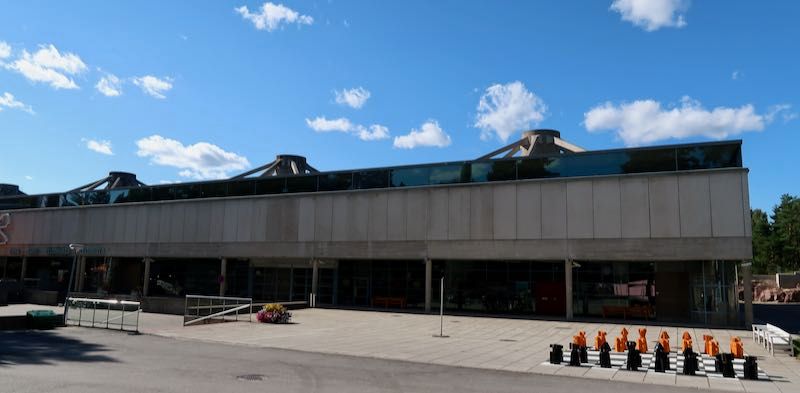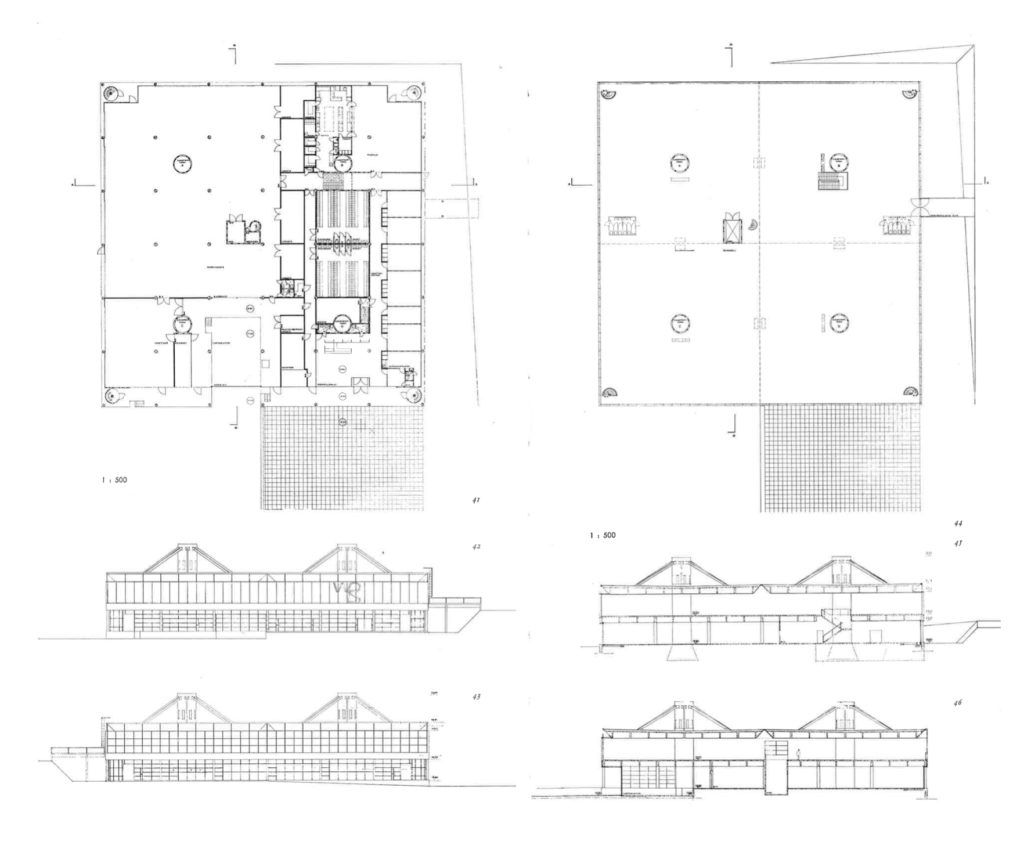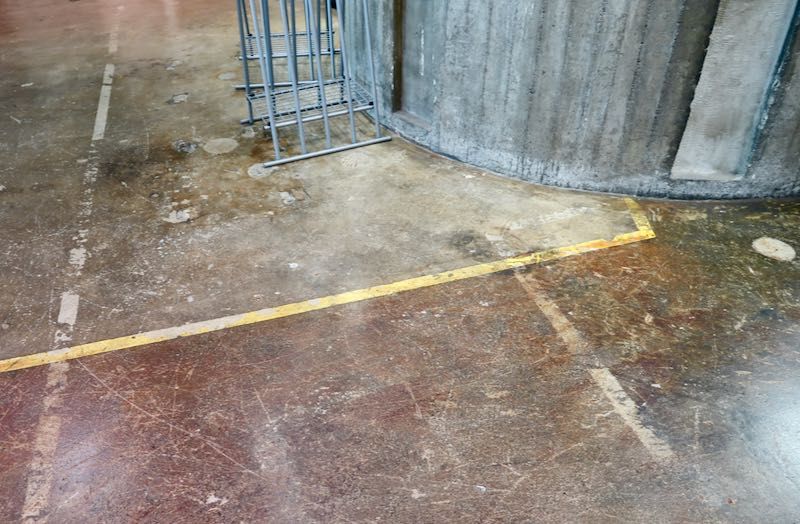The WeeGee building by Aarno Ruusuvuori
A factory from the sixties, a constructivist classic converted with care in 2006 into and art and museum center.

WeeGee Art Gallery after restoration (Photo: Lewis Martin)
Details
- Completed: 1st stage 1964, second stage 1966, third phase 1974
as WeeGee art Center in 2006 - Address: Ahertajantie 5, 02100 Espoo, Finland
- Size: 23,000 sqm
- Architect: Aarno Ruusuvuori
First Life
The location is close to Helsinki, at the time it was a light industrial area in Espoo on the outskirts of the Tapiola Garden City a new town development closely modelled and designed on a post war suburban city model. The development of Tapiola is definitely worth a post in the future by itself.

Designed by Aarno Ruusuvuori in 1964, the building was originally used as a printing press before it was bought by the City of Espoo in 2001. Photo: Valokuvaamo Pietiläinen / EKM
A printing company required a new headquarters and print works. The requirements of the brief were split into two clear floors. Service and storage areas for the printing press on the ground floor and on the 1st floor were the giant printing machines.

Main facade, The Weiling & Göös Printing House 1st phase
The building plan was divided into 27 x 27 m bays. There are smaller columns at 9 m intervals but at the center of every 27m bay is a concrete pylon 3m in diameter which goes up through the building. It further comes up through the roof of the building and suspends it. Inside the pylons were ventilation plants an idea of Ruusuvuori and the structural designer Bertel Ekengren.

Plans, Sections Elevations
This meant that each grid block was in theory independant of the other. So conceptually the building can be as big or small as needed and expand or contract as the requirements of the factory change. The pylons and column structure furthermore meant the clearspace inside was maximised so there was as little as possible getting in the way of the giant printing machines.
The Elevations are treated as plains so while the 1st floor is quite blank on the front elevation it is a completely open glass wall on the back elevation allowing the views of nature next to the whirring of the giant printing presses.
It is a quite lovely Constructivist building the form in section, plan and structure address the requirements of the brief in a very direct way. The first phase in 1964 had 4 of these 27m blocks and the second phase in 1966 added another 4 blocks.

Interior, The WeeGee when it was a printing press (© Valokuvaamo Pietinen / Espoo City Museum)
There was a third phase designed by Bertel Ekengren completed in spring 1974 which doesn’t conform to the structural concept laid out by Ruusuvuori, and a forth phase planned but never completed.
Another company WSOY bought Weilin & Göös in 1992 and the printing works were moved out. Then the building hosted many different temporary activities, for example a Chineese restaurant and a floorball court to name just two.
Second Life
In 2001 the City of Espoo purchased the building and made a plan to restore and convert it into a flexible museum and art gallery.
The building had a second life as the WeeGee Art Center in 2006.

A park is retained at the back (Photo: Lewis Martin)
The second life or renewal of the building was designed by Arias Architects (Timo Airas and Henna Helander). There was alot of extension work. The concrete was renewed, new lifts and stairs were added and a basement the whole length of the building excavated adding in total over 300 new rooms to the building. Most of the exterior cladding concrete panels had to be remade so the scope of the renovation was large.

New Staircase inserted (Photo: Lewis Martin)
The character of the building though was retained. The concrete pylons, the brutally constructivist facades the plain concrete floors.
It is a shining example of a sympathetic renewal of a grand old building which updates the use of the building without destroying the original character.
The WeeGee building now contains the Espoo Museum of Modern Art (EMMA), Espoo City Museum, the Finnish Museum of Horology, the Finnish Toy Museum, Studio Suuronen among other things.
Also part of the permanent collection of the museum is one of the few remaining Futuro Houses which is now open to the public.
About Aarno Ruusuvuori
The Architect of the building Aarno Ruusuvuori came from a poor background, fought in WWII and applied and got into Ottaniemi to study Architecture after the war. In the mid fifties he started to rise in prominence and in Finland is one of the foremost Constructivist Architects. I have pulled a couple of quotes from the book Aarno Ruusuvuori Structure is The Key to Beauty to illustrate his thinking and his start in Architectural practice.
Then you set up your own office?
The Helsinki Olympics were held in 1952; I escaped the Olympic Building Office at the end of 1951 and set up my own office. It was easy, after all: all I needed was a drawing board and a telephone. And then, furious competition. At first my office was in my parents’ home; later I rented the Sauna of a block of flats at the corner of Merkatu and Huvilakatu streets. It’s use was forbidden. I had noticed it on my way home along Merikatu street: the attic balcony, the door and window hammered shut with planks, and the swaying shirt-cuffs I could see behind them. I thought, that is one hell of a place for drying shirts. I went and talked to the housing company, and they let me have the space for a limited period; I was allowed to build a studio in the wash and changing room. It was ready in 1956 and I moved out of my old home. After the war it was not at all easy to get an apartment. I lived in the attic, more or less under my drawing board, for years. The office got going, at its best there were five or six of us , and there we did a number of competitions.
I am sure I would never have got any work, and I think that many others would also have remained unemployed, if it had not been for the competition system. That’s how you start out as a young architect, after all: design and lose, design and lose. Then you score your first success. For me it was the Hyrylä-Tuusula primary school, some time in the mid 1950s
Aulis Blomstedt had a measuring system based on musical harmony, which he adapted to design work. What is your theoretical starting point?
Allu’s theory of relations has been important to me. I modulate all my buildings, because without a mathematical tuning fork I believe dimensions are difficult to control, especially in the vertical plane. Mathematical structure is an unconditional feature of my work. Mathematics is meant to explain things: it is easier to understand an environment with a mathematical character. And anyway, because of Aalto’s individual architectural thought and his brilliant gifts, the field of free form seemed pretty well full, so I thought it best to do something else, where I could work on my own. The force of Aalto directed me to another road: that is one reason why I shifted to a more rational approach and sought more generally applicable solutions, rather than making each building as individual as possible.

Pylons Retained and Integrated into the Art gallery
Criticism
In my view this building deserves more attention than it often gets. A great constructivist factory in the woods converted with care and insight into an urban art gallery.
The direct nature of this constructivist even brutalist building is refreshing. However this building is a fine example of a structural solution which manages still to have a poetic heart. The roof is hung from its massive concrete pylons like the trunks of trees evoking a canopy of concrete. This is strenghtend by the direct connection to the large pines at the back of the site which were retained and which refract the light coming into the building.
The conversion manages at the same time to retain the original character of the building and give art a new lease of life. But everywhere there is a light touch, look at the floor and you can still see the ghostly imprints of the taped and treated floor presumably from when it was a printworks.

Original Concrete floor with the ghost marks of when the building was a printing press (Phots: Lewis Martin)
Further Reading
- Kultturiespoo website gives a nice history of the building.
- navi.finnisharchitectuer as a nice page on it.
- Wee Gee is listed on do.co.mo.mo finland
- The Book Aarno Ruusuvuori Structure is The Key to Beauty in Finnish and English is well worth a read.